Monopoly Market and Economic Recession: Rising Poverty
VerifiedAdded on 2022/07/28
|11
|2957
|17
Essay
AI Summary
This essay explores the adverse effects of monopoly market structures and economic recessions on poverty. It examines how the characteristics of monopolies, such as price-making power and barriers to entry, contribute to market inefficiencies and price discrimination, leading to wealth inequality. The essay discusses the role of capitalism, the concept of poverty tax, and the impact of globalization in exacerbating these issues. It analyzes the ways in which monopolistic practices, particularly during economic downturns, disproportionately affect low-income individuals, making them more vulnerable to debt and financial hardship. The essay proposes solutions such as increasing market competition, reducing capitalism's dominance, and reforming tax structures to alleviate the burden on the poor. It emphasizes the need for government intervention to regulate monopolies and promote policies that support public sector organizations and reduce wealth inequality, ultimately aiming to reduce poverty.
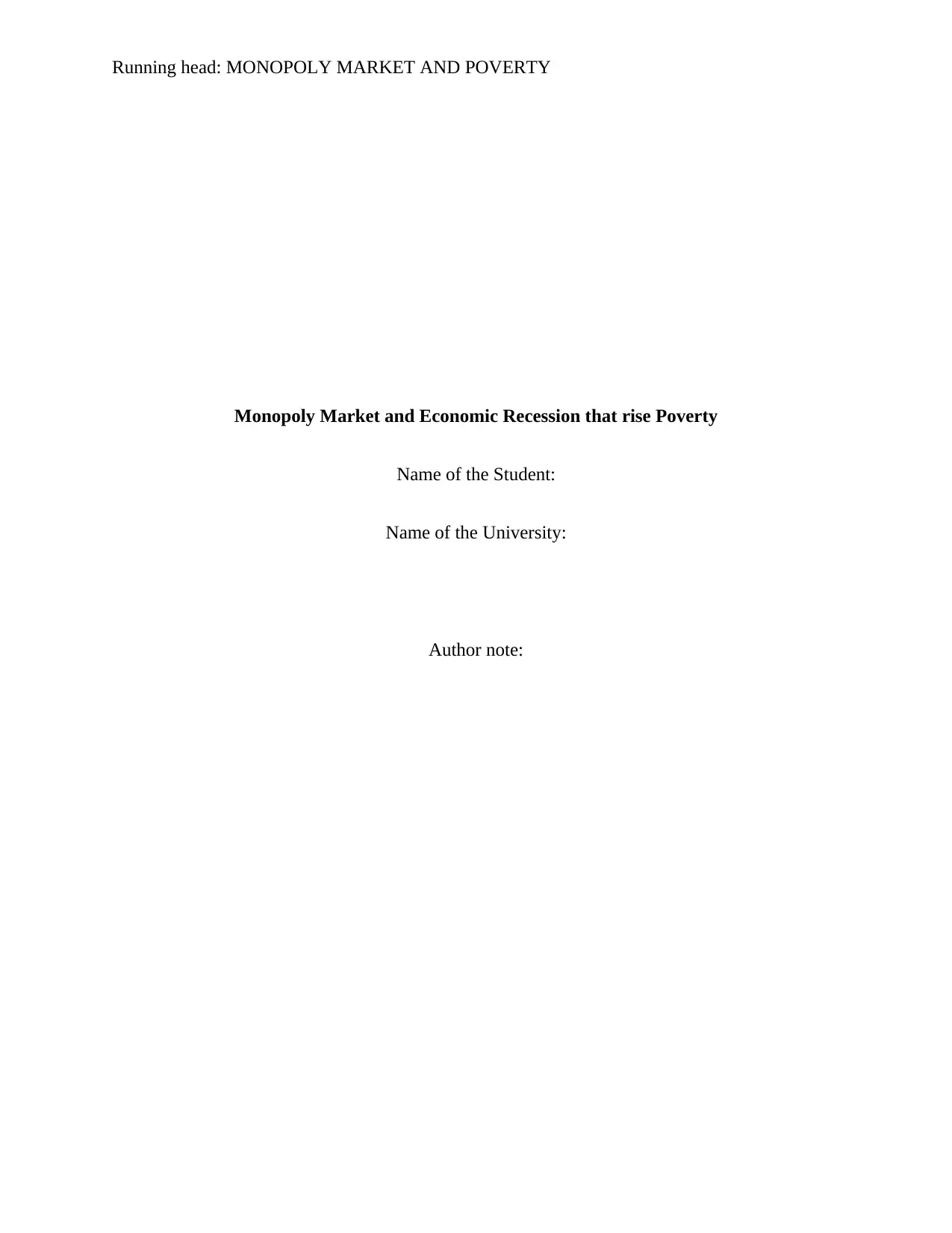
Running head: MONOPOLY MARKET AND POVERTY
Monopoly Market and Economic Recession that rise Poverty
Name of the Student:
Name of the University:
Author note:
Monopoly Market and Economic Recession that rise Poverty
Name of the Student:
Name of the University:
Author note:
Paraphrase This Document
Need a fresh take? Get an instant paraphrase of this document with our AI Paraphraser
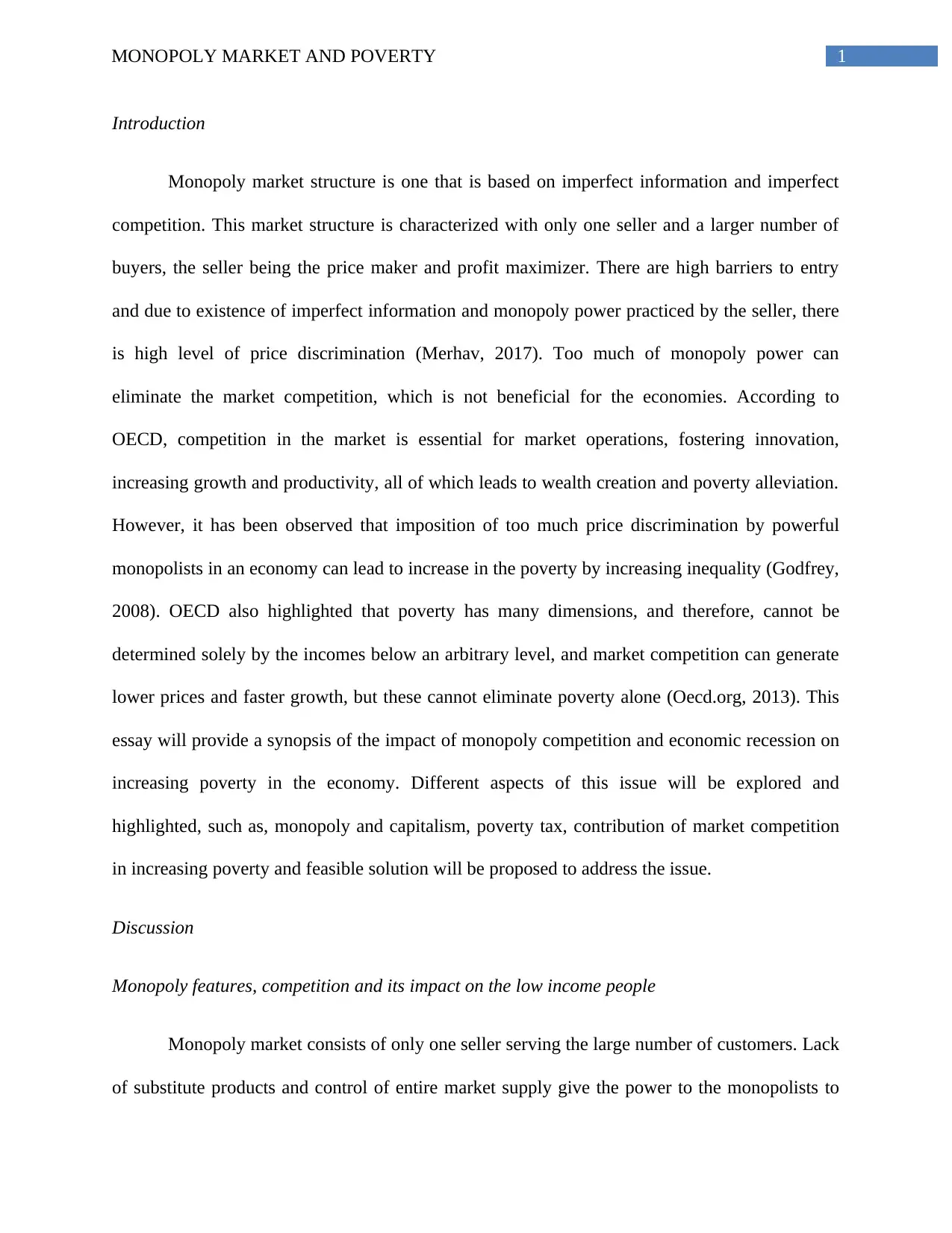
1MONOPOLY MARKET AND POVERTY
Introduction
Monopoly market structure is one that is based on imperfect information and imperfect
competition. This market structure is characterized with only one seller and a larger number of
buyers, the seller being the price maker and profit maximizer. There are high barriers to entry
and due to existence of imperfect information and monopoly power practiced by the seller, there
is high level of price discrimination (Merhav, 2017). Too much of monopoly power can
eliminate the market competition, which is not beneficial for the economies. According to
OECD, competition in the market is essential for market operations, fostering innovation,
increasing growth and productivity, all of which leads to wealth creation and poverty alleviation.
However, it has been observed that imposition of too much price discrimination by powerful
monopolists in an economy can lead to increase in the poverty by increasing inequality (Godfrey,
2008). OECD also highlighted that poverty has many dimensions, and therefore, cannot be
determined solely by the incomes below an arbitrary level, and market competition can generate
lower prices and faster growth, but these cannot eliminate poverty alone (Oecd.org, 2013). This
essay will provide a synopsis of the impact of monopoly competition and economic recession on
increasing poverty in the economy. Different aspects of this issue will be explored and
highlighted, such as, monopoly and capitalism, poverty tax, contribution of market competition
in increasing poverty and feasible solution will be proposed to address the issue.
Discussion
Monopoly features, competition and its impact on the low income people
Monopoly market consists of only one seller serving the large number of customers. Lack
of substitute products and control of entire market supply give the power to the monopolists to
Introduction
Monopoly market structure is one that is based on imperfect information and imperfect
competition. This market structure is characterized with only one seller and a larger number of
buyers, the seller being the price maker and profit maximizer. There are high barriers to entry
and due to existence of imperfect information and monopoly power practiced by the seller, there
is high level of price discrimination (Merhav, 2017). Too much of monopoly power can
eliminate the market competition, which is not beneficial for the economies. According to
OECD, competition in the market is essential for market operations, fostering innovation,
increasing growth and productivity, all of which leads to wealth creation and poverty alleviation.
However, it has been observed that imposition of too much price discrimination by powerful
monopolists in an economy can lead to increase in the poverty by increasing inequality (Godfrey,
2008). OECD also highlighted that poverty has many dimensions, and therefore, cannot be
determined solely by the incomes below an arbitrary level, and market competition can generate
lower prices and faster growth, but these cannot eliminate poverty alone (Oecd.org, 2013). This
essay will provide a synopsis of the impact of monopoly competition and economic recession on
increasing poverty in the economy. Different aspects of this issue will be explored and
highlighted, such as, monopoly and capitalism, poverty tax, contribution of market competition
in increasing poverty and feasible solution will be proposed to address the issue.
Discussion
Monopoly features, competition and its impact on the low income people
Monopoly market consists of only one seller serving the large number of customers. Lack
of substitute products and control of entire market supply give the power to the monopolists to
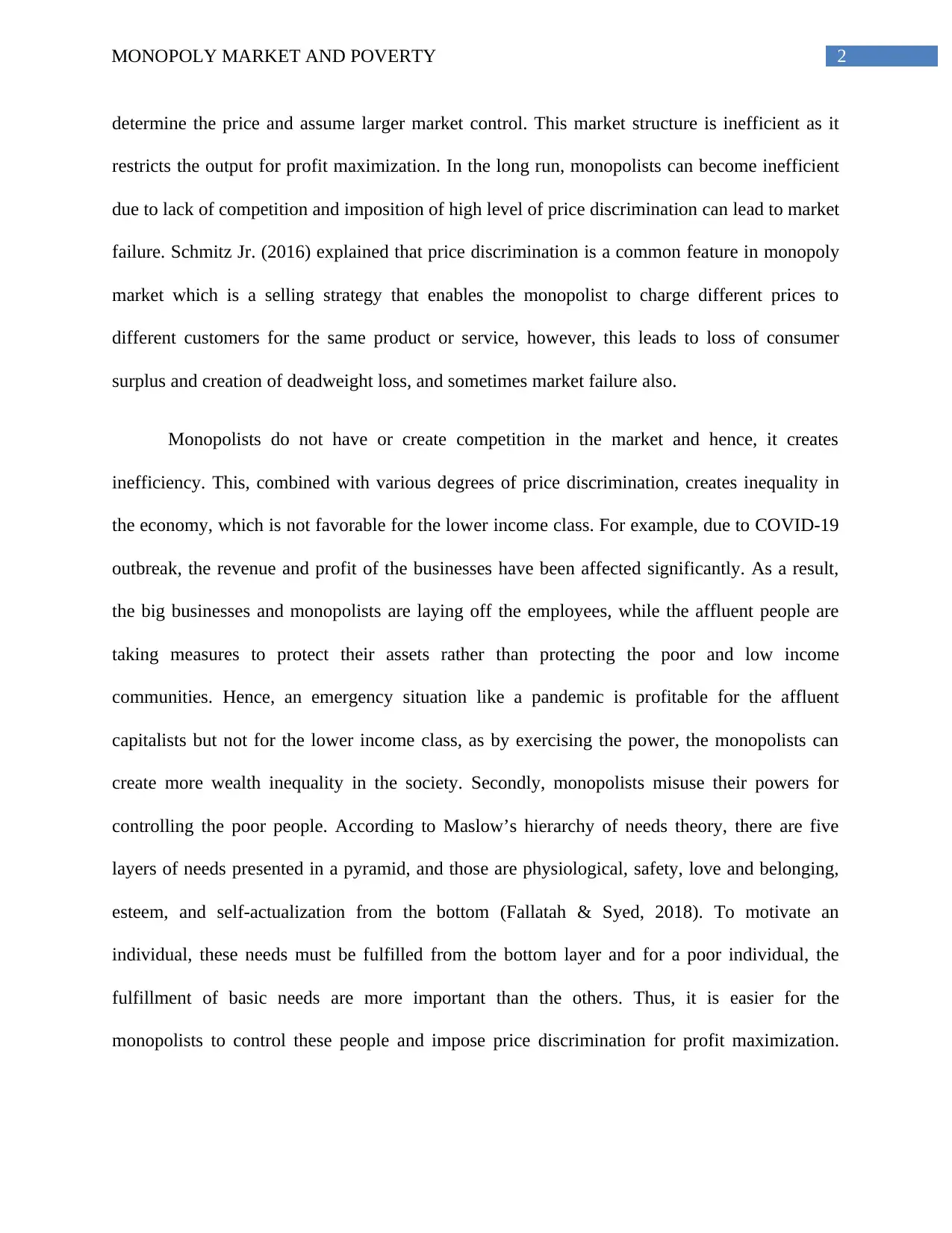
2MONOPOLY MARKET AND POVERTY
determine the price and assume larger market control. This market structure is inefficient as it
restricts the output for profit maximization. In the long run, monopolists can become inefficient
due to lack of competition and imposition of high level of price discrimination can lead to market
failure. Schmitz Jr. (2016) explained that price discrimination is a common feature in monopoly
market which is a selling strategy that enables the monopolist to charge different prices to
different customers for the same product or service, however, this leads to loss of consumer
surplus and creation of deadweight loss, and sometimes market failure also.
Monopolists do not have or create competition in the market and hence, it creates
inefficiency. This, combined with various degrees of price discrimination, creates inequality in
the economy, which is not favorable for the lower income class. For example, due to COVID-19
outbreak, the revenue and profit of the businesses have been affected significantly. As a result,
the big businesses and monopolists are laying off the employees, while the affluent people are
taking measures to protect their assets rather than protecting the poor and low income
communities. Hence, an emergency situation like a pandemic is profitable for the affluent
capitalists but not for the lower income class, as by exercising the power, the monopolists can
create more wealth inequality in the society. Secondly, monopolists misuse their powers for
controlling the poor people. According to Maslow’s hierarchy of needs theory, there are five
layers of needs presented in a pyramid, and those are physiological, safety, love and belonging,
esteem, and self-actualization from the bottom (Fallatah & Syed, 2018). To motivate an
individual, these needs must be fulfilled from the bottom layer and for a poor individual, the
fulfillment of basic needs are more important than the others. Thus, it is easier for the
monopolists to control these people and impose price discrimination for profit maximization.
determine the price and assume larger market control. This market structure is inefficient as it
restricts the output for profit maximization. In the long run, monopolists can become inefficient
due to lack of competition and imposition of high level of price discrimination can lead to market
failure. Schmitz Jr. (2016) explained that price discrimination is a common feature in monopoly
market which is a selling strategy that enables the monopolist to charge different prices to
different customers for the same product or service, however, this leads to loss of consumer
surplus and creation of deadweight loss, and sometimes market failure also.
Monopolists do not have or create competition in the market and hence, it creates
inefficiency. This, combined with various degrees of price discrimination, creates inequality in
the economy, which is not favorable for the lower income class. For example, due to COVID-19
outbreak, the revenue and profit of the businesses have been affected significantly. As a result,
the big businesses and monopolists are laying off the employees, while the affluent people are
taking measures to protect their assets rather than protecting the poor and low income
communities. Hence, an emergency situation like a pandemic is profitable for the affluent
capitalists but not for the lower income class, as by exercising the power, the monopolists can
create more wealth inequality in the society. Secondly, monopolists misuse their powers for
controlling the poor people. According to Maslow’s hierarchy of needs theory, there are five
layers of needs presented in a pyramid, and those are physiological, safety, love and belonging,
esteem, and self-actualization from the bottom (Fallatah & Syed, 2018). To motivate an
individual, these needs must be fulfilled from the bottom layer and for a poor individual, the
fulfillment of basic needs are more important than the others. Thus, it is easier for the
monopolists to control these people and impose price discrimination for profit maximization.
⊘ This is a preview!⊘
Do you want full access?
Subscribe today to unlock all pages.

Trusted by 1+ million students worldwide
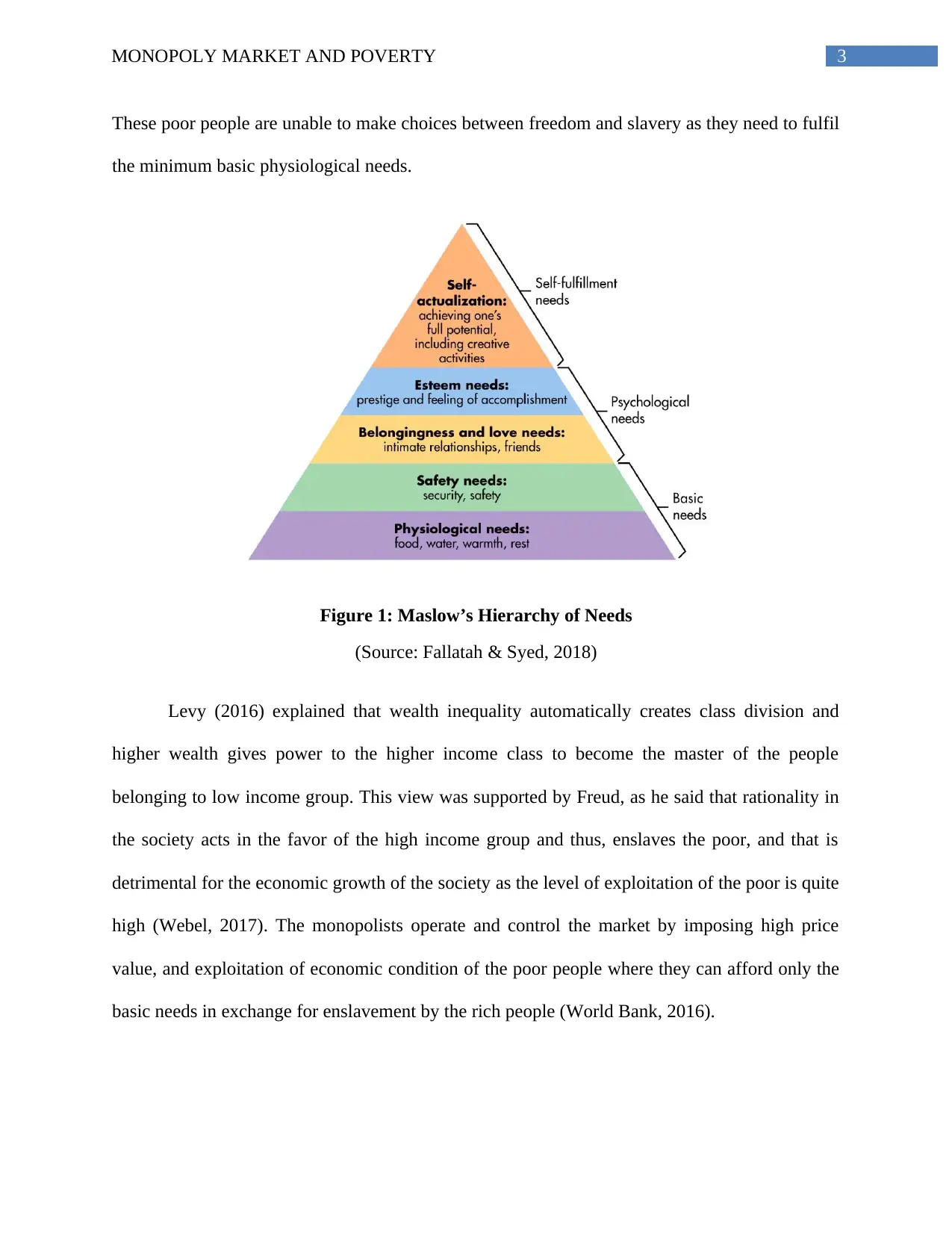
3MONOPOLY MARKET AND POVERTY
These poor people are unable to make choices between freedom and slavery as they need to fulfil
the minimum basic physiological needs.
Figure 1: Maslow’s Hierarchy of Needs
(Source: Fallatah & Syed, 2018)
Levy (2016) explained that wealth inequality automatically creates class division and
higher wealth gives power to the higher income class to become the master of the people
belonging to low income group. This view was supported by Freud, as he said that rationality in
the society acts in the favor of the high income group and thus, enslaves the poor, and that is
detrimental for the economic growth of the society as the level of exploitation of the poor is quite
high (Webel, 2017). The monopolists operate and control the market by imposing high price
value, and exploitation of economic condition of the poor people where they can afford only the
basic needs in exchange for enslavement by the rich people (World Bank, 2016).
These poor people are unable to make choices between freedom and slavery as they need to fulfil
the minimum basic physiological needs.
Figure 1: Maslow’s Hierarchy of Needs
(Source: Fallatah & Syed, 2018)
Levy (2016) explained that wealth inequality automatically creates class division and
higher wealth gives power to the higher income class to become the master of the people
belonging to low income group. This view was supported by Freud, as he said that rationality in
the society acts in the favor of the high income group and thus, enslaves the poor, and that is
detrimental for the economic growth of the society as the level of exploitation of the poor is quite
high (Webel, 2017). The monopolists operate and control the market by imposing high price
value, and exploitation of economic condition of the poor people where they can afford only the
basic needs in exchange for enslavement by the rich people (World Bank, 2016).
Paraphrase This Document
Need a fresh take? Get an instant paraphrase of this document with our AI Paraphraser
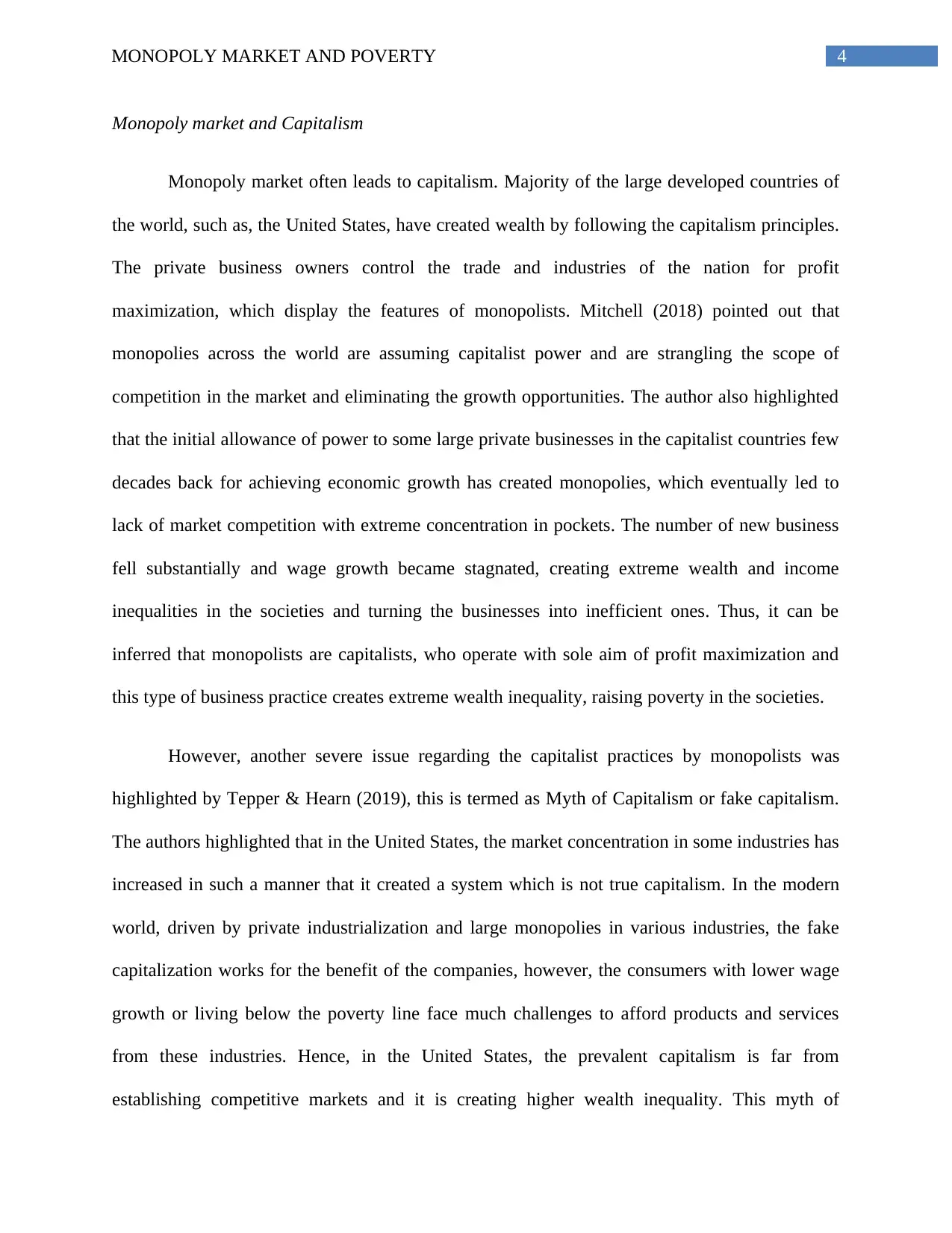
4MONOPOLY MARKET AND POVERTY
Monopoly market and Capitalism
Monopoly market often leads to capitalism. Majority of the large developed countries of
the world, such as, the United States, have created wealth by following the capitalism principles.
The private business owners control the trade and industries of the nation for profit
maximization, which display the features of monopolists. Mitchell (2018) pointed out that
monopolies across the world are assuming capitalist power and are strangling the scope of
competition in the market and eliminating the growth opportunities. The author also highlighted
that the initial allowance of power to some large private businesses in the capitalist countries few
decades back for achieving economic growth has created monopolies, which eventually led to
lack of market competition with extreme concentration in pockets. The number of new business
fell substantially and wage growth became stagnated, creating extreme wealth and income
inequalities in the societies and turning the businesses into inefficient ones. Thus, it can be
inferred that monopolists are capitalists, who operate with sole aim of profit maximization and
this type of business practice creates extreme wealth inequality, raising poverty in the societies.
However, another severe issue regarding the capitalist practices by monopolists was
highlighted by Tepper & Hearn (2019), this is termed as Myth of Capitalism or fake capitalism.
The authors highlighted that in the United States, the market concentration in some industries has
increased in such a manner that it created a system which is not true capitalism. In the modern
world, driven by private industrialization and large monopolies in various industries, the fake
capitalization works for the benefit of the companies, however, the consumers with lower wage
growth or living below the poverty line face much challenges to afford products and services
from these industries. Hence, in the United States, the prevalent capitalism is far from
establishing competitive markets and it is creating higher wealth inequality. This myth of
Monopoly market and Capitalism
Monopoly market often leads to capitalism. Majority of the large developed countries of
the world, such as, the United States, have created wealth by following the capitalism principles.
The private business owners control the trade and industries of the nation for profit
maximization, which display the features of monopolists. Mitchell (2018) pointed out that
monopolies across the world are assuming capitalist power and are strangling the scope of
competition in the market and eliminating the growth opportunities. The author also highlighted
that the initial allowance of power to some large private businesses in the capitalist countries few
decades back for achieving economic growth has created monopolies, which eventually led to
lack of market competition with extreme concentration in pockets. The number of new business
fell substantially and wage growth became stagnated, creating extreme wealth and income
inequalities in the societies and turning the businesses into inefficient ones. Thus, it can be
inferred that monopolists are capitalists, who operate with sole aim of profit maximization and
this type of business practice creates extreme wealth inequality, raising poverty in the societies.
However, another severe issue regarding the capitalist practices by monopolists was
highlighted by Tepper & Hearn (2019), this is termed as Myth of Capitalism or fake capitalism.
The authors highlighted that in the United States, the market concentration in some industries has
increased in such a manner that it created a system which is not true capitalism. In the modern
world, driven by private industrialization and large monopolies in various industries, the fake
capitalization works for the benefit of the companies, however, the consumers with lower wage
growth or living below the poverty line face much challenges to afford products and services
from these industries. Hence, in the United States, the prevalent capitalism is far from
establishing competitive markets and it is creating higher wealth inequality. This myth of
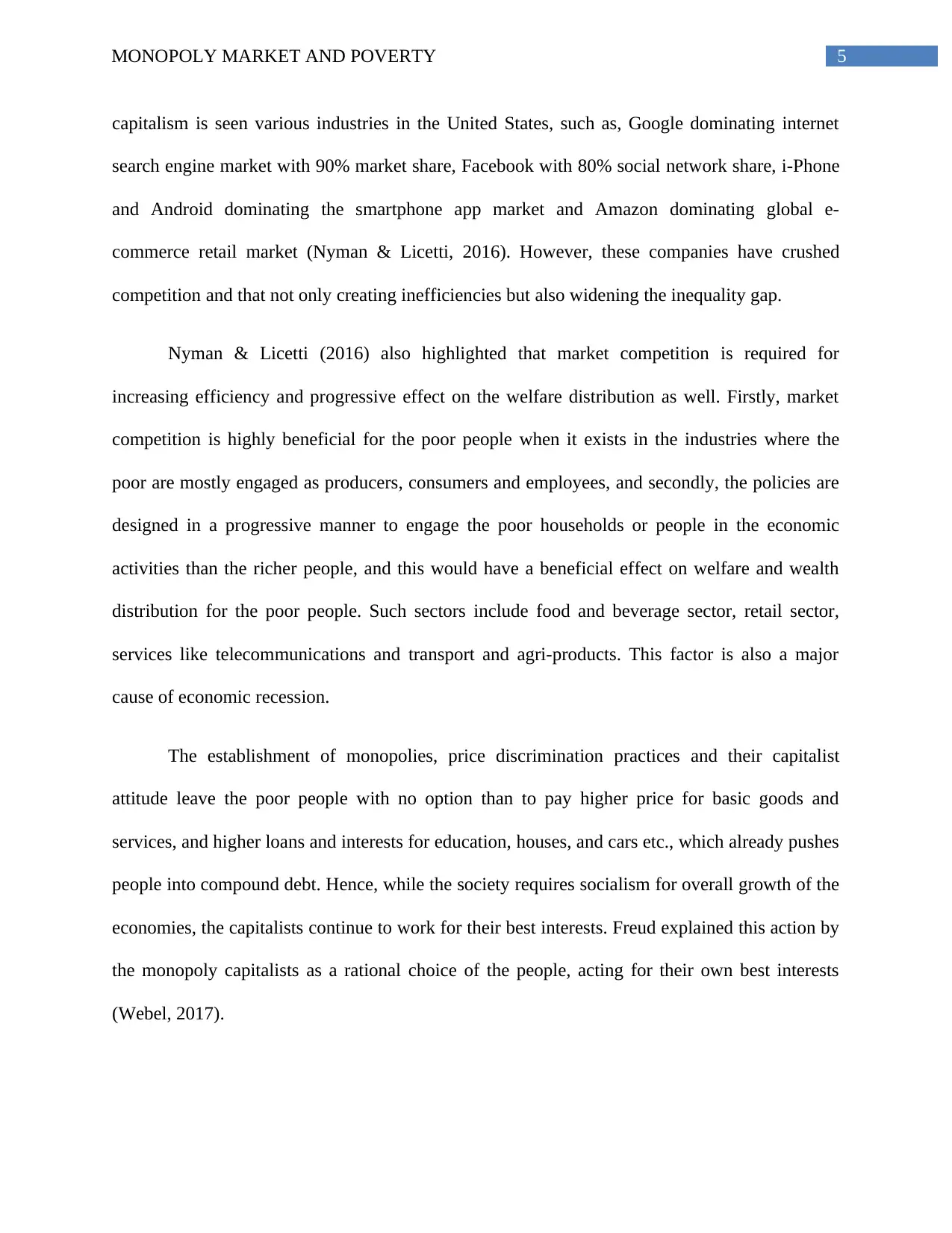
5MONOPOLY MARKET AND POVERTY
capitalism is seen various industries in the United States, such as, Google dominating internet
search engine market with 90% market share, Facebook with 80% social network share, i-Phone
and Android dominating the smartphone app market and Amazon dominating global e-
commerce retail market (Nyman & Licetti, 2016). However, these companies have crushed
competition and that not only creating inefficiencies but also widening the inequality gap.
Nyman & Licetti (2016) also highlighted that market competition is required for
increasing efficiency and progressive effect on the welfare distribution as well. Firstly, market
competition is highly beneficial for the poor people when it exists in the industries where the
poor are mostly engaged as producers, consumers and employees, and secondly, the policies are
designed in a progressive manner to engage the poor households or people in the economic
activities than the richer people, and this would have a beneficial effect on welfare and wealth
distribution for the poor people. Such sectors include food and beverage sector, retail sector,
services like telecommunications and transport and agri-products. This factor is also a major
cause of economic recession.
The establishment of monopolies, price discrimination practices and their capitalist
attitude leave the poor people with no option than to pay higher price for basic goods and
services, and higher loans and interests for education, houses, and cars etc., which already pushes
people into compound debt. Hence, while the society requires socialism for overall growth of the
economies, the capitalists continue to work for their best interests. Freud explained this action by
the monopoly capitalists as a rational choice of the people, acting for their own best interests
(Webel, 2017).
capitalism is seen various industries in the United States, such as, Google dominating internet
search engine market with 90% market share, Facebook with 80% social network share, i-Phone
and Android dominating the smartphone app market and Amazon dominating global e-
commerce retail market (Nyman & Licetti, 2016). However, these companies have crushed
competition and that not only creating inefficiencies but also widening the inequality gap.
Nyman & Licetti (2016) also highlighted that market competition is required for
increasing efficiency and progressive effect on the welfare distribution as well. Firstly, market
competition is highly beneficial for the poor people when it exists in the industries where the
poor are mostly engaged as producers, consumers and employees, and secondly, the policies are
designed in a progressive manner to engage the poor households or people in the economic
activities than the richer people, and this would have a beneficial effect on welfare and wealth
distribution for the poor people. Such sectors include food and beverage sector, retail sector,
services like telecommunications and transport and agri-products. This factor is also a major
cause of economic recession.
The establishment of monopolies, price discrimination practices and their capitalist
attitude leave the poor people with no option than to pay higher price for basic goods and
services, and higher loans and interests for education, houses, and cars etc., which already pushes
people into compound debt. Hence, while the society requires socialism for overall growth of the
economies, the capitalists continue to work for their best interests. Freud explained this action by
the monopoly capitalists as a rational choice of the people, acting for their own best interests
(Webel, 2017).
⊘ This is a preview!⊘
Do you want full access?
Subscribe today to unlock all pages.

Trusted by 1+ million students worldwide
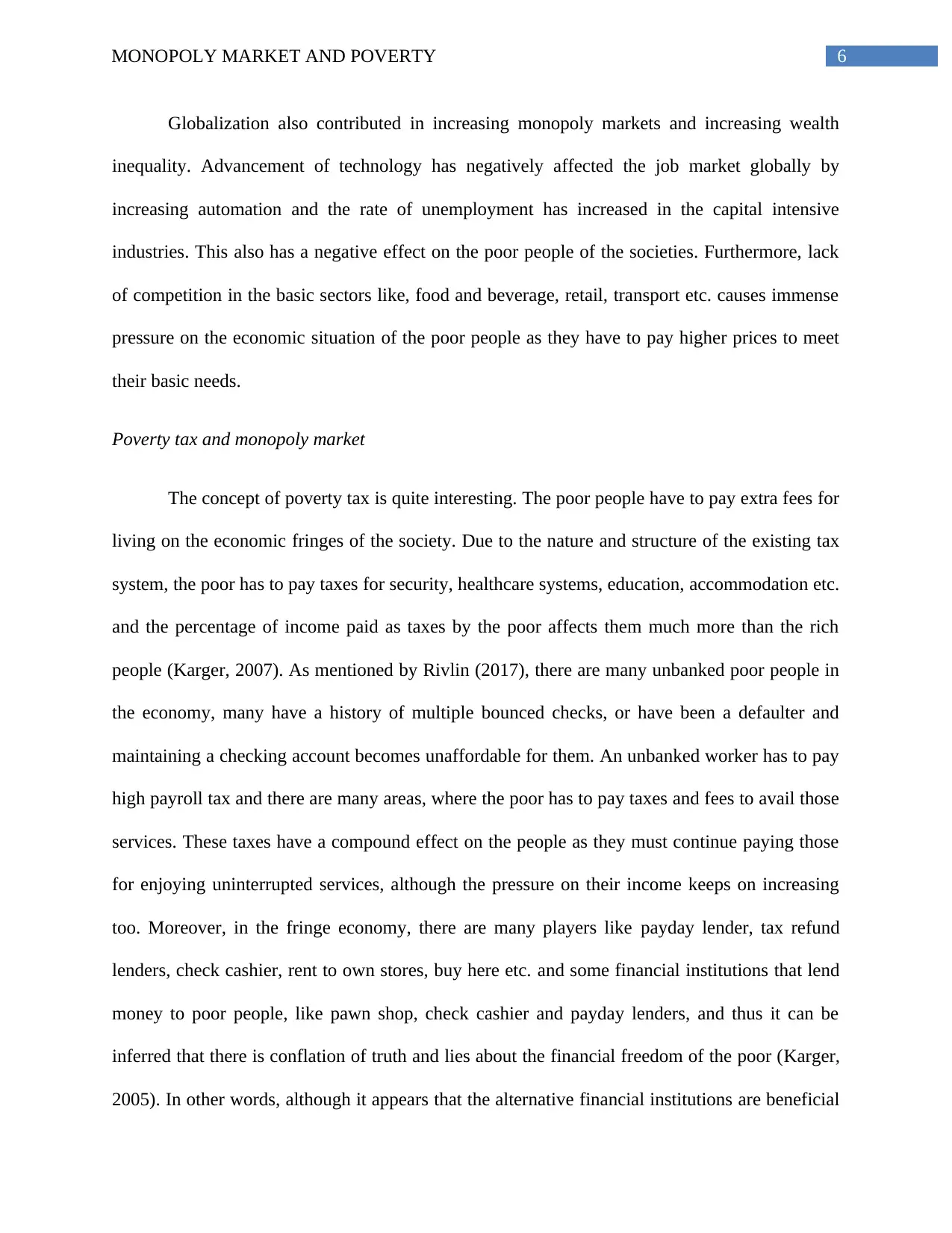
6MONOPOLY MARKET AND POVERTY
Globalization also contributed in increasing monopoly markets and increasing wealth
inequality. Advancement of technology has negatively affected the job market globally by
increasing automation and the rate of unemployment has increased in the capital intensive
industries. This also has a negative effect on the poor people of the societies. Furthermore, lack
of competition in the basic sectors like, food and beverage, retail, transport etc. causes immense
pressure on the economic situation of the poor people as they have to pay higher prices to meet
their basic needs.
Poverty tax and monopoly market
The concept of poverty tax is quite interesting. The poor people have to pay extra fees for
living on the economic fringes of the society. Due to the nature and structure of the existing tax
system, the poor has to pay taxes for security, healthcare systems, education, accommodation etc.
and the percentage of income paid as taxes by the poor affects them much more than the rich
people (Karger, 2007). As mentioned by Rivlin (2017), there are many unbanked poor people in
the economy, many have a history of multiple bounced checks, or have been a defaulter and
maintaining a checking account becomes unaffordable for them. An unbanked worker has to pay
high payroll tax and there are many areas, where the poor has to pay taxes and fees to avail those
services. These taxes have a compound effect on the people as they must continue paying those
for enjoying uninterrupted services, although the pressure on their income keeps on increasing
too. Moreover, in the fringe economy, there are many players like payday lender, tax refund
lenders, check cashier, rent to own stores, buy here etc. and some financial institutions that lend
money to poor people, like pawn shop, check cashier and payday lenders, and thus it can be
inferred that there is conflation of truth and lies about the financial freedom of the poor (Karger,
2005). In other words, although it appears that the alternative financial institutions are beneficial
Globalization also contributed in increasing monopoly markets and increasing wealth
inequality. Advancement of technology has negatively affected the job market globally by
increasing automation and the rate of unemployment has increased in the capital intensive
industries. This also has a negative effect on the poor people of the societies. Furthermore, lack
of competition in the basic sectors like, food and beverage, retail, transport etc. causes immense
pressure on the economic situation of the poor people as they have to pay higher prices to meet
their basic needs.
Poverty tax and monopoly market
The concept of poverty tax is quite interesting. The poor people have to pay extra fees for
living on the economic fringes of the society. Due to the nature and structure of the existing tax
system, the poor has to pay taxes for security, healthcare systems, education, accommodation etc.
and the percentage of income paid as taxes by the poor affects them much more than the rich
people (Karger, 2007). As mentioned by Rivlin (2017), there are many unbanked poor people in
the economy, many have a history of multiple bounced checks, or have been a defaulter and
maintaining a checking account becomes unaffordable for them. An unbanked worker has to pay
high payroll tax and there are many areas, where the poor has to pay taxes and fees to avail those
services. These taxes have a compound effect on the people as they must continue paying those
for enjoying uninterrupted services, although the pressure on their income keeps on increasing
too. Moreover, in the fringe economy, there are many players like payday lender, tax refund
lenders, check cashier, rent to own stores, buy here etc. and some financial institutions that lend
money to poor people, like pawn shop, check cashier and payday lenders, and thus it can be
inferred that there is conflation of truth and lies about the financial freedom of the poor (Karger,
2005). In other words, although it appears that the alternative financial institutions are beneficial
Paraphrase This Document
Need a fresh take? Get an instant paraphrase of this document with our AI Paraphraser
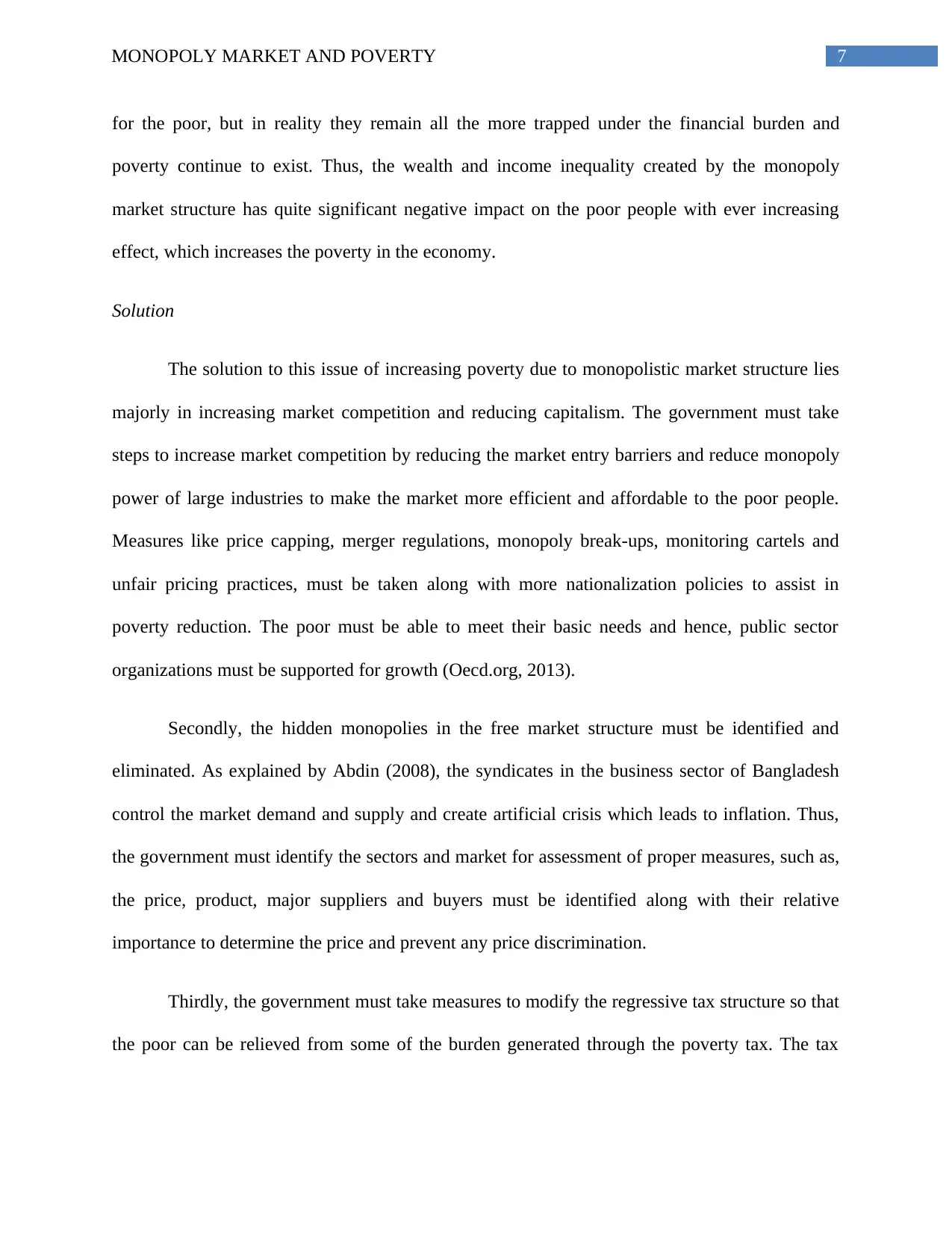
7MONOPOLY MARKET AND POVERTY
for the poor, but in reality they remain all the more trapped under the financial burden and
poverty continue to exist. Thus, the wealth and income inequality created by the monopoly
market structure has quite significant negative impact on the poor people with ever increasing
effect, which increases the poverty in the economy.
Solution
The solution to this issue of increasing poverty due to monopolistic market structure lies
majorly in increasing market competition and reducing capitalism. The government must take
steps to increase market competition by reducing the market entry barriers and reduce monopoly
power of large industries to make the market more efficient and affordable to the poor people.
Measures like price capping, merger regulations, monopoly break-ups, monitoring cartels and
unfair pricing practices, must be taken along with more nationalization policies to assist in
poverty reduction. The poor must be able to meet their basic needs and hence, public sector
organizations must be supported for growth (Oecd.org, 2013).
Secondly, the hidden monopolies in the free market structure must be identified and
eliminated. As explained by Abdin (2008), the syndicates in the business sector of Bangladesh
control the market demand and supply and create artificial crisis which leads to inflation. Thus,
the government must identify the sectors and market for assessment of proper measures, such as,
the price, product, major suppliers and buyers must be identified along with their relative
importance to determine the price and prevent any price discrimination.
Thirdly, the government must take measures to modify the regressive tax structure so that
the poor can be relieved from some of the burden generated through the poverty tax. The tax
for the poor, but in reality they remain all the more trapped under the financial burden and
poverty continue to exist. Thus, the wealth and income inequality created by the monopoly
market structure has quite significant negative impact on the poor people with ever increasing
effect, which increases the poverty in the economy.
Solution
The solution to this issue of increasing poverty due to monopolistic market structure lies
majorly in increasing market competition and reducing capitalism. The government must take
steps to increase market competition by reducing the market entry barriers and reduce monopoly
power of large industries to make the market more efficient and affordable to the poor people.
Measures like price capping, merger regulations, monopoly break-ups, monitoring cartels and
unfair pricing practices, must be taken along with more nationalization policies to assist in
poverty reduction. The poor must be able to meet their basic needs and hence, public sector
organizations must be supported for growth (Oecd.org, 2013).
Secondly, the hidden monopolies in the free market structure must be identified and
eliminated. As explained by Abdin (2008), the syndicates in the business sector of Bangladesh
control the market demand and supply and create artificial crisis which leads to inflation. Thus,
the government must identify the sectors and market for assessment of proper measures, such as,
the price, product, major suppliers and buyers must be identified along with their relative
importance to determine the price and prevent any price discrimination.
Thirdly, the government must take measures to modify the regressive tax structure so that
the poor can be relieved from some of the burden generated through the poverty tax. The tax
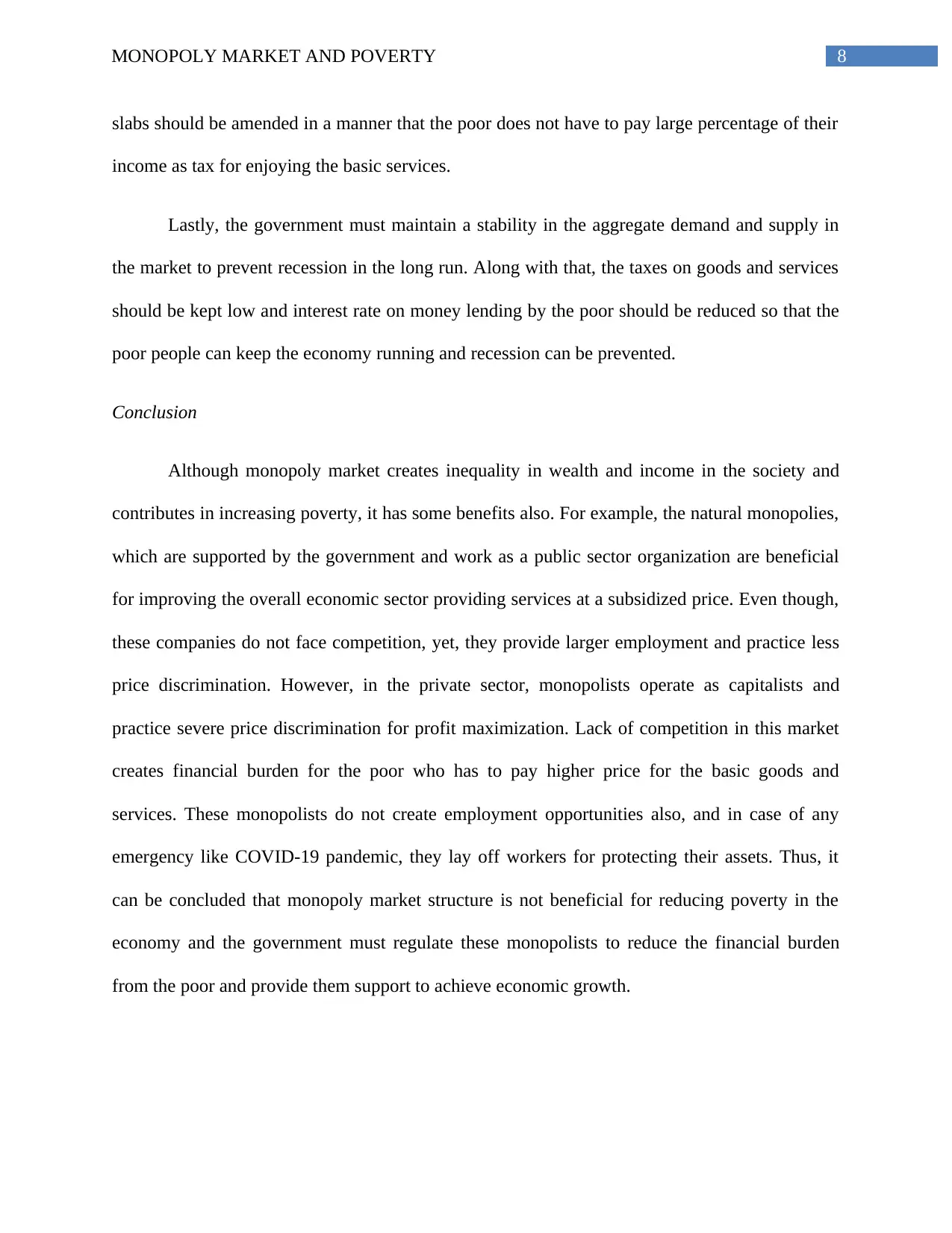
8MONOPOLY MARKET AND POVERTY
slabs should be amended in a manner that the poor does not have to pay large percentage of their
income as tax for enjoying the basic services.
Lastly, the government must maintain a stability in the aggregate demand and supply in
the market to prevent recession in the long run. Along with that, the taxes on goods and services
should be kept low and interest rate on money lending by the poor should be reduced so that the
poor people can keep the economy running and recession can be prevented.
Conclusion
Although monopoly market creates inequality in wealth and income in the society and
contributes in increasing poverty, it has some benefits also. For example, the natural monopolies,
which are supported by the government and work as a public sector organization are beneficial
for improving the overall economic sector providing services at a subsidized price. Even though,
these companies do not face competition, yet, they provide larger employment and practice less
price discrimination. However, in the private sector, monopolists operate as capitalists and
practice severe price discrimination for profit maximization. Lack of competition in this market
creates financial burden for the poor who has to pay higher price for the basic goods and
services. These monopolists do not create employment opportunities also, and in case of any
emergency like COVID-19 pandemic, they lay off workers for protecting their assets. Thus, it
can be concluded that monopoly market structure is not beneficial for reducing poverty in the
economy and the government must regulate these monopolists to reduce the financial burden
from the poor and provide them support to achieve economic growth.
slabs should be amended in a manner that the poor does not have to pay large percentage of their
income as tax for enjoying the basic services.
Lastly, the government must maintain a stability in the aggregate demand and supply in
the market to prevent recession in the long run. Along with that, the taxes on goods and services
should be kept low and interest rate on money lending by the poor should be reduced so that the
poor people can keep the economy running and recession can be prevented.
Conclusion
Although monopoly market creates inequality in wealth and income in the society and
contributes in increasing poverty, it has some benefits also. For example, the natural monopolies,
which are supported by the government and work as a public sector organization are beneficial
for improving the overall economic sector providing services at a subsidized price. Even though,
these companies do not face competition, yet, they provide larger employment and practice less
price discrimination. However, in the private sector, monopolists operate as capitalists and
practice severe price discrimination for profit maximization. Lack of competition in this market
creates financial burden for the poor who has to pay higher price for the basic goods and
services. These monopolists do not create employment opportunities also, and in case of any
emergency like COVID-19 pandemic, they lay off workers for protecting their assets. Thus, it
can be concluded that monopoly market structure is not beneficial for reducing poverty in the
economy and the government must regulate these monopolists to reduce the financial burden
from the poor and provide them support to achieve economic growth.
⊘ This is a preview!⊘
Do you want full access?
Subscribe today to unlock all pages.

Trusted by 1+ million students worldwide
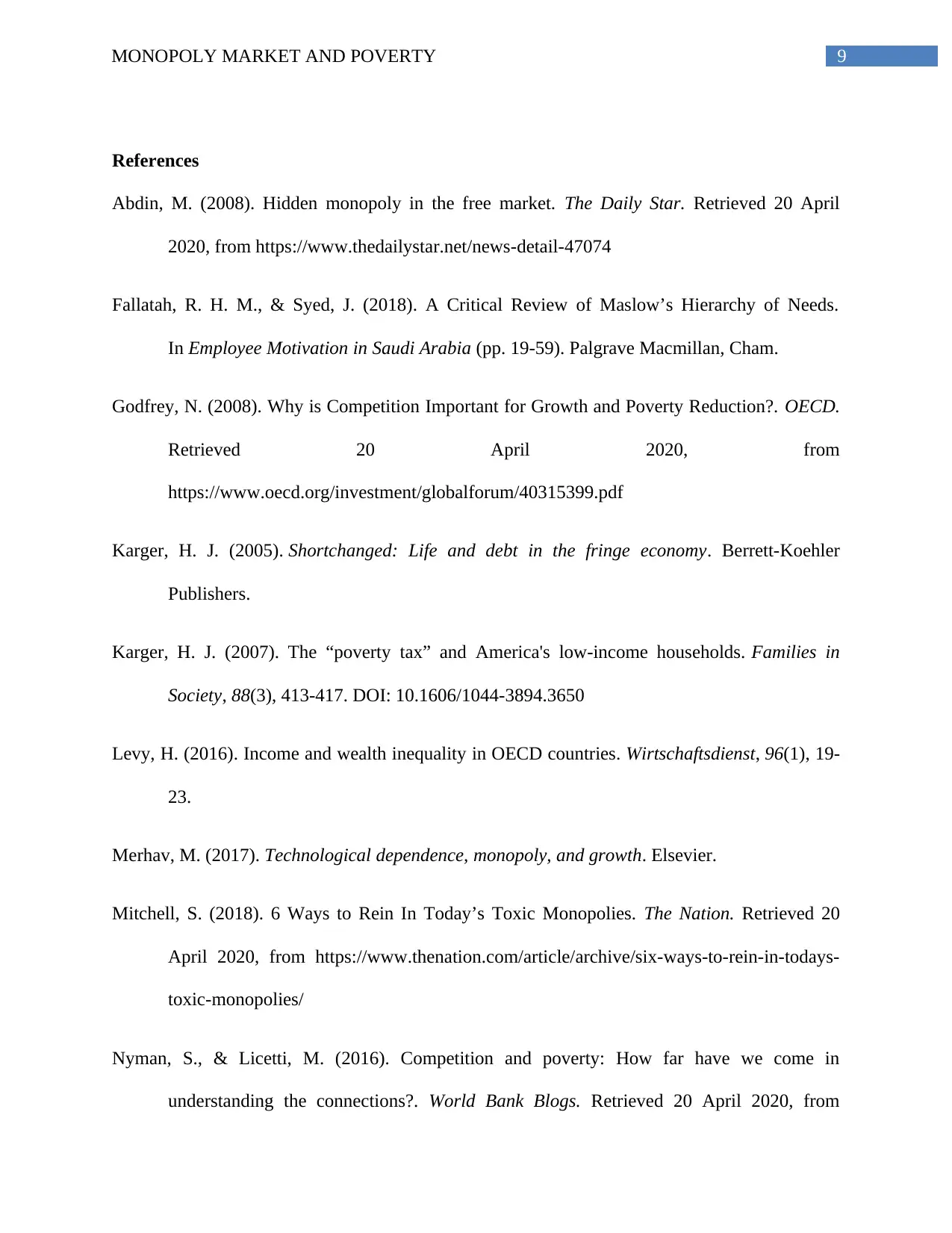
9MONOPOLY MARKET AND POVERTY
References
Abdin, M. (2008). Hidden monopoly in the free market. The Daily Star. Retrieved 20 April
2020, from https://www.thedailystar.net/news-detail-47074
Fallatah, R. H. M., & Syed, J. (2018). A Critical Review of Maslow’s Hierarchy of Needs.
In Employee Motivation in Saudi Arabia (pp. 19-59). Palgrave Macmillan, Cham.
Godfrey, N. (2008). Why is Competition Important for Growth and Poverty Reduction?. OECD.
Retrieved 20 April 2020, from
https://www.oecd.org/investment/globalforum/40315399.pdf
Karger, H. J. (2005). Shortchanged: Life and debt in the fringe economy. Berrett-Koehler
Publishers.
Karger, H. J. (2007). The “poverty tax” and America's low-income households. Families in
Society, 88(3), 413-417. DOI: 10.1606/1044-3894.3650
Levy, H. (2016). Income and wealth inequality in OECD countries. Wirtschaftsdienst, 96(1), 19-
23.
Merhav, M. (2017). Technological dependence, monopoly, and growth. Elsevier.
Mitchell, S. (2018). 6 Ways to Rein In Today’s Toxic Monopolies. The Nation. Retrieved 20
April 2020, from https://www.thenation.com/article/archive/six-ways-to-rein-in-todays-
toxic-monopolies/
Nyman, S., & Licetti, M. (2016). Competition and poverty: How far have we come in
understanding the connections?. World Bank Blogs. Retrieved 20 April 2020, from
References
Abdin, M. (2008). Hidden monopoly in the free market. The Daily Star. Retrieved 20 April
2020, from https://www.thedailystar.net/news-detail-47074
Fallatah, R. H. M., & Syed, J. (2018). A Critical Review of Maslow’s Hierarchy of Needs.
In Employee Motivation in Saudi Arabia (pp. 19-59). Palgrave Macmillan, Cham.
Godfrey, N. (2008). Why is Competition Important for Growth and Poverty Reduction?. OECD.
Retrieved 20 April 2020, from
https://www.oecd.org/investment/globalforum/40315399.pdf
Karger, H. J. (2005). Shortchanged: Life and debt in the fringe economy. Berrett-Koehler
Publishers.
Karger, H. J. (2007). The “poverty tax” and America's low-income households. Families in
Society, 88(3), 413-417. DOI: 10.1606/1044-3894.3650
Levy, H. (2016). Income and wealth inequality in OECD countries. Wirtschaftsdienst, 96(1), 19-
23.
Merhav, M. (2017). Technological dependence, monopoly, and growth. Elsevier.
Mitchell, S. (2018). 6 Ways to Rein In Today’s Toxic Monopolies. The Nation. Retrieved 20
April 2020, from https://www.thenation.com/article/archive/six-ways-to-rein-in-todays-
toxic-monopolies/
Nyman, S., & Licetti, M. (2016). Competition and poverty: How far have we come in
understanding the connections?. World Bank Blogs. Retrieved 20 April 2020, from
Paraphrase This Document
Need a fresh take? Get an instant paraphrase of this document with our AI Paraphraser
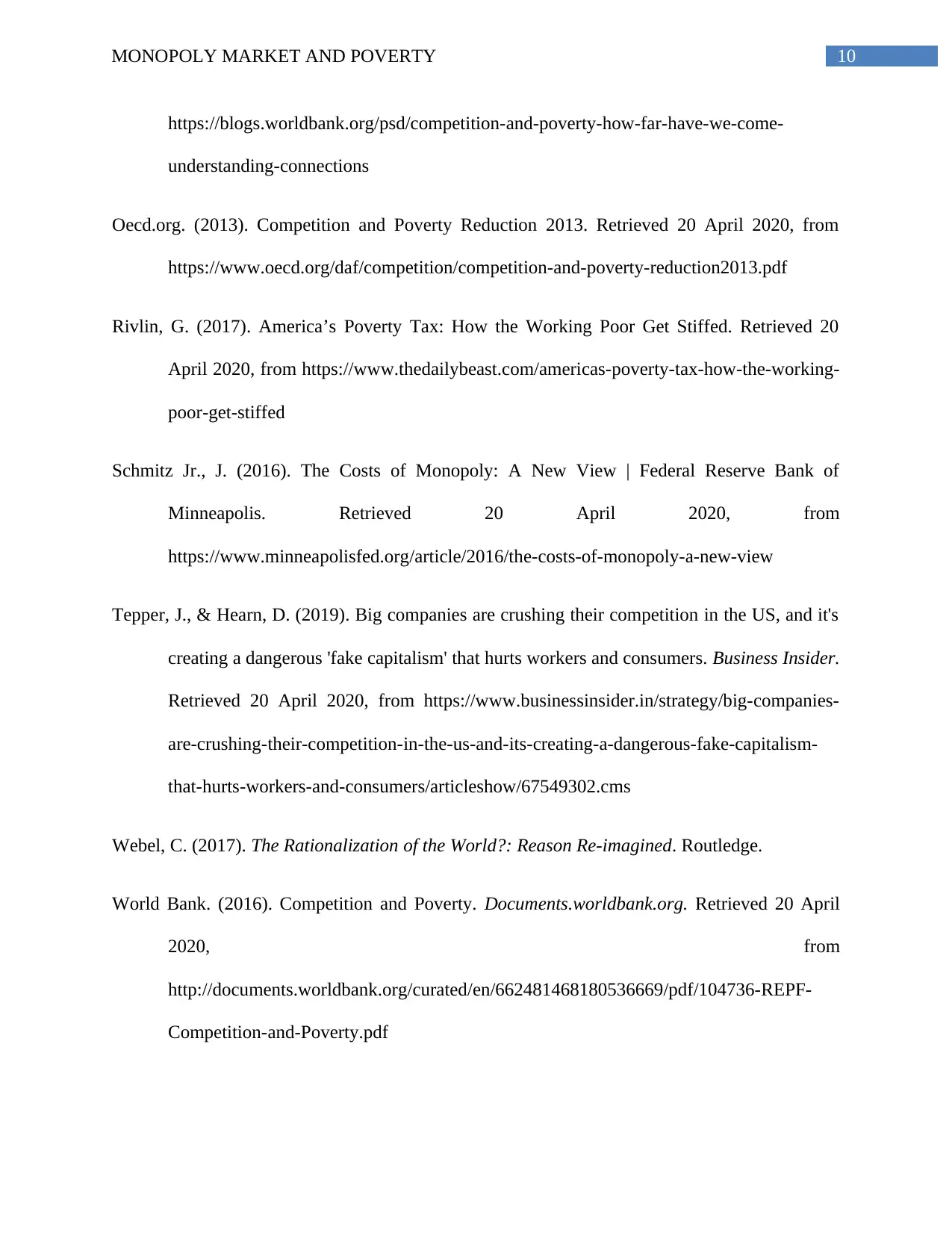
10MONOPOLY MARKET AND POVERTY
https://blogs.worldbank.org/psd/competition-and-poverty-how-far-have-we-come-
understanding-connections
Oecd.org. (2013). Competition and Poverty Reduction 2013. Retrieved 20 April 2020, from
https://www.oecd.org/daf/competition/competition-and-poverty-reduction2013.pdf
Rivlin, G. (2017). America’s Poverty Tax: How the Working Poor Get Stiffed. Retrieved 20
April 2020, from https://www.thedailybeast.com/americas-poverty-tax-how-the-working-
poor-get-stiffed
Schmitz Jr., J. (2016). The Costs of Monopoly: A New View | Federal Reserve Bank of
Minneapolis. Retrieved 20 April 2020, from
https://www.minneapolisfed.org/article/2016/the-costs-of-monopoly-a-new-view
Tepper, J., & Hearn, D. (2019). Big companies are crushing their competition in the US, and it's
creating a dangerous 'fake capitalism' that hurts workers and consumers. Business Insider.
Retrieved 20 April 2020, from https://www.businessinsider.in/strategy/big-companies-
are-crushing-their-competition-in-the-us-and-its-creating-a-dangerous-fake-capitalism-
that-hurts-workers-and-consumers/articleshow/67549302.cms
Webel, C. (2017). The Rationalization of the World?: Reason Re-imagined. Routledge.
World Bank. (2016). Competition and Poverty. Documents.worldbank.org. Retrieved 20 April
2020, from
http://documents.worldbank.org/curated/en/662481468180536669/pdf/104736-REPF-
Competition-and-Poverty.pdf
https://blogs.worldbank.org/psd/competition-and-poverty-how-far-have-we-come-
understanding-connections
Oecd.org. (2013). Competition and Poverty Reduction 2013. Retrieved 20 April 2020, from
https://www.oecd.org/daf/competition/competition-and-poverty-reduction2013.pdf
Rivlin, G. (2017). America’s Poverty Tax: How the Working Poor Get Stiffed. Retrieved 20
April 2020, from https://www.thedailybeast.com/americas-poverty-tax-how-the-working-
poor-get-stiffed
Schmitz Jr., J. (2016). The Costs of Monopoly: A New View | Federal Reserve Bank of
Minneapolis. Retrieved 20 April 2020, from
https://www.minneapolisfed.org/article/2016/the-costs-of-monopoly-a-new-view
Tepper, J., & Hearn, D. (2019). Big companies are crushing their competition in the US, and it's
creating a dangerous 'fake capitalism' that hurts workers and consumers. Business Insider.
Retrieved 20 April 2020, from https://www.businessinsider.in/strategy/big-companies-
are-crushing-their-competition-in-the-us-and-its-creating-a-dangerous-fake-capitalism-
that-hurts-workers-and-consumers/articleshow/67549302.cms
Webel, C. (2017). The Rationalization of the World?: Reason Re-imagined. Routledge.
World Bank. (2016). Competition and Poverty. Documents.worldbank.org. Retrieved 20 April
2020, from
http://documents.worldbank.org/curated/en/662481468180536669/pdf/104736-REPF-
Competition-and-Poverty.pdf
1 out of 11
Related Documents
Your All-in-One AI-Powered Toolkit for Academic Success.
+13062052269
info@desklib.com
Available 24*7 on WhatsApp / Email
![[object Object]](/_next/static/media/star-bottom.7253800d.svg)
Unlock your academic potential
Copyright © 2020–2025 A2Z Services. All Rights Reserved. Developed and managed by ZUCOL.





